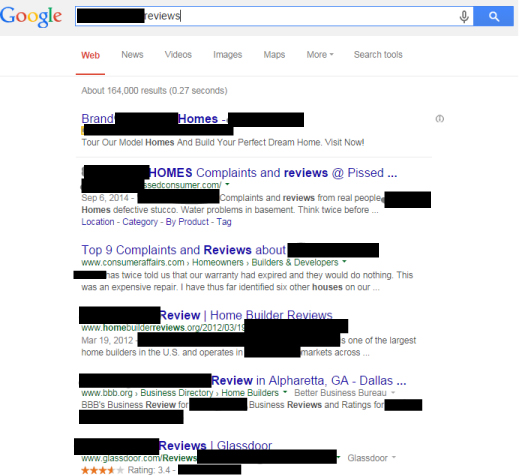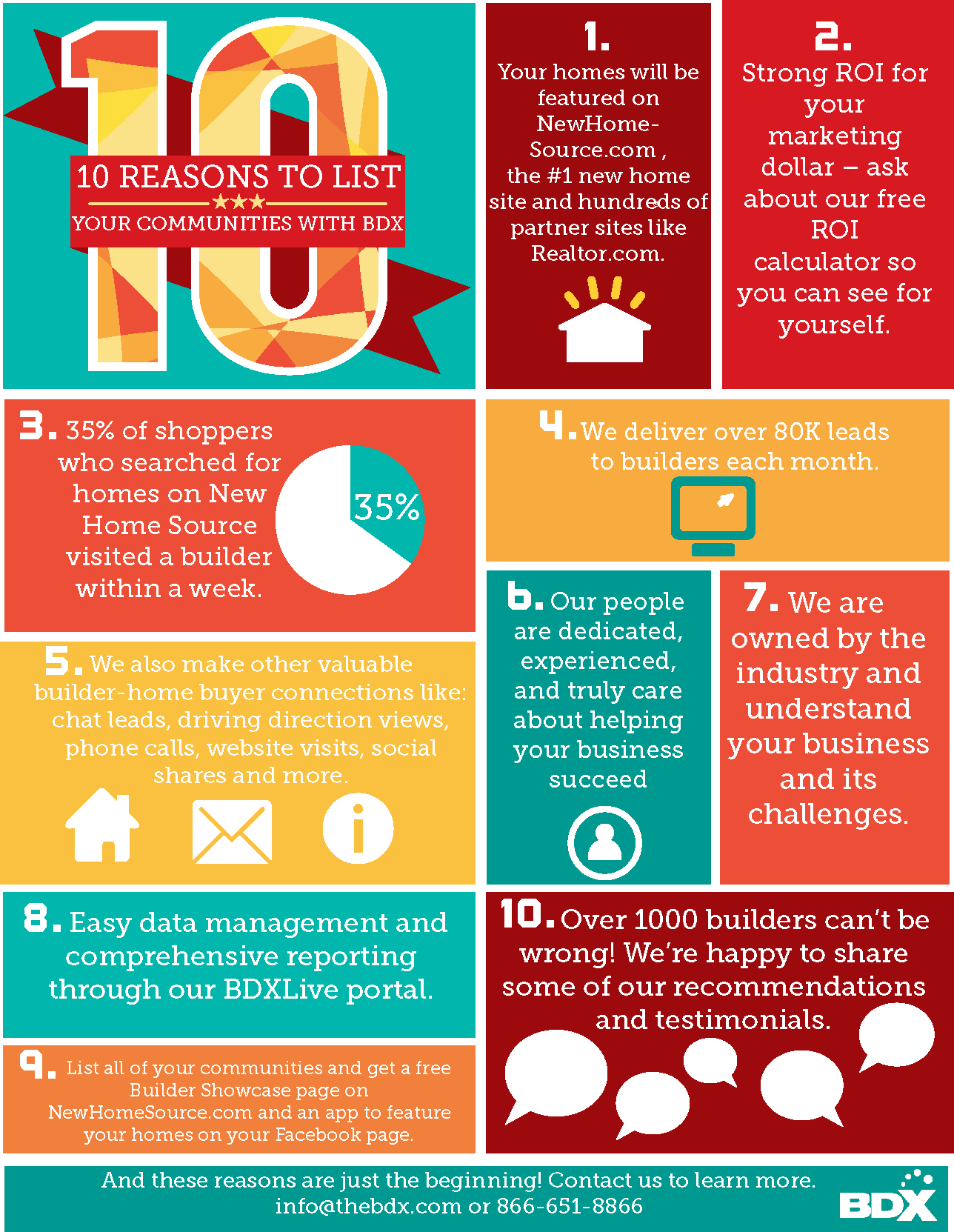This is the first out of four blogs in our online reputation management series.
Builders can’t hide their reputation. It’s highly visible and immediately accessible. Today, your reputation is the magazine cover feature your customer can’t help but notice. Just do a Google search for “[Builder Name] reviews,” and you will likely find every wart exposed for the world to see. Here’s what I found for one top builder on the first page of Google (unfortunately, this builder is not alone).

Consumers have changed. Today, savvy consumers check online reviews for just about everything they buy. A new home may be a consumer’s largest lifetime purchase decision. You think they aren’t going to check out who’s building and providing warranty service? And unfortunately, negative reviews are more common than positive reviews.
It probably does not feel fair, but it is reality. Builders need to turn their reputation into an asset by doing two things:
1) Highlight the Positive. The vast majority of your buyers probably love their home, think their builder is fantastic and may consider their builder among their best friends. Positive opinions are out there, but they are not always online – it’s your job to help bring these positive stories to life.
2) Make it Right. We all make mistakes, but how you manage your business, employees, and customers and how you respond to an issue is highly visible to anyone considering your brand. Define your online reputation before someone else does it for you.
8 Steps to Improving Your Online Reputation
The builder above is losing sales, but they can fix it. Here’s how:
1) First, set expectations with your buyers. Home buyers need to understand that home building is a very human business. Mistakes will happen, but buyers must understand and believe you will be there to correct any mistake. Be humble and remind them that it is a human business, but that you are committed to them. Make this part of your pre-build process. Make it easy for buyers to give feedback. Then walk the talk, and measure it.
2) Audit and monitor your brand online. There are numerous tools available free or at some cost that will email you anytime your brand is mentioned in social media or on select websites. Look for an upcoming article for a step-by-step process for Auditing and Monitoring Your Online Reputation.
3) Respond to negative reviews quickly and publically. Don’t let bad reviews cause further damage to your brand by going unanswered. Not only will delays allow the current situation to get worse, but you may lose sales that are pending. Solely responding privately may be the worst thing you can do. That said, there are right and wrong ways to respond. Later in this series, we will show you How to Respond to Negative Online Reviews. These tips on responding to unfavorable or negative reviews will put out the fire while calming prospective clients and employees who are evaluating your brand.
4) Recruit satisfied customers to write positive reviews. Focus on Google+. You need at least 5 reviews before your star rating will be displayed in local search results. There are three times in the building process you should ask for reviews: One, right after the buyer signs the contract. They are euphoric, probably appreciative for any extras or discounts you may have extended to them. You have not even had time to make mistakes. Two, after a successful walk-though once follow-up items are addressed. Three, anytime your client sends a thank you note or expresses sincere appreciation for your team’s efforts. Ask them if they will help by reviewing your business on Google+. Send them the direct link to the URL via email to make it easy. Then follow-up to thank them or send them something as a token of your appreciation.
5) Be Proactive: Stop bad reviews before they happen by being proactive in seeking feedback. There are many moments of truth for builders. One of the most important is right after a walk-through of the home. The consumer has a chance to identify all the things they feel needs to be addressed before closing. Be like the good doctor who calls his patient after a procedure to see how they are feeling. Address issues quickly and effectively and negative reviews are unlikely to be posted. The other critical time for home builders to check in is after warranty service calls. Are you making it easy for consumers to file a claim? Are you responding to them in a manner that meets or exceeds expectations you help set? Ask them and then follow-up. The money you spend now will save sales later.
6) Be Accessible: Stop brewing bad reviews by making sure it is easy to contact senior company representatives. A bad review is often in response to a delayed response to a problem you would normally immediately fix. If they know they have your attention, they are less likely to write a bad review. Don’t ask them to write a bad review by being inaccessible.
7) Own or control your page #1 search results in Google When someone searches for “[Your Brand Term]” or “[Your Brand Term] Reviews” you need to own these pages. For your brand term, this is pretty easy. By setting up your major social profiles and linking to them along with other pages/sites you control, you will be there. We recommend the following: LinkedIn, Facebook, YouTube (assuming you have video), Pinterest, your blog (if a different sub-domain, your Twitter account (if active), and sites you control such as your profile on Career Builder and your builder profile on New Home Source. Here’s a sample from David Weekley Homes Profile and Reviews on NewHomeSource.com. They added their testimonials and dozens of beautiful pictures to help complete the brand message. If your company has been profiled in one of New Home Source’s “Builder Innovations” articles, this can greatly augment your brand position. See Lennar Homes recent innovation that was featured. Finish out page #1 by promoting favorable items on page #2 and #3 of the search results by linking to them in a search engine effective way. You will own page #1. Owning Page #1 of “[Your Brand Term] Reviews” search results can be more difficult. For these you need search friendly pages for reviews. Start with your own website by adding a “reviews and testimonials” page. Leverage your social media controlled pages (e.g., LinkedIn, Facebook) to help control page #1. Show the world what your customers say about you. If you have a Houzz account that looks good and has multiple reviews, link to that as well. Link to your profile and builder innovations on Newhomesource.com, you will likely push down less relevant content you do not control. These also are essentially consumer testimonials optimized for this purpose. Finally, consider operating a “work for [Brand Name]” site for recruitment and posting employee reviews and testimonials.
8) Push negative content down by promoting positive news and reviews. If you can’t delete or get a retraction, your only option is to make the bad content less visible relative to your positive content. You want these items pushed to page two. The only way you can push a negative content to page two of a Google search results page is to get 10 other things to be considered more relevant to Google. Make your owned or controlled pages rank higher by making them more relevant in search engines for the consumer’s query. Review sites are probably considered highly relevant for the term “reviews,” but that does not mean they are applicable for your brand term. So, you have to be more relevant to the consumer’s query to win the rank and satisfy consumers with the content you have. This is all about search engine optimization (SEO).
Are there eight steps to improving your online reputation? Not really. There is only one that always works. Strive to Be Better.
If you have any questions or would like to discuss ways to improve your online reputation with one of our digital marketing consultants, email us at Info@theBDX.com.



